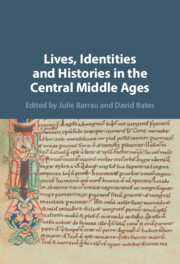Book contents
- Lives, Identities and Histories in the Central Middle Ages
- Lives, Identities and Histories in the Central Middle Ages
- Copyright page
- Contents
- Figures
- Contributors
- Abbreviations
- Introduction
- Part I Entwined Lives and Multiple Identities
- 1 Mother and Motherhood in the Vita et Passio Willelmi Norwicensis
- 2 Prayer for the Dead:
- 3 Authority over Men and the Allocation of Riches:
- 4 Flemish Settlement and Maritime Traffic in the South-West Peninsula of Britain, c. 1050–1250
- 5 Cistercians and the Laity in Twelfth- and Thirteenth-Century Upper Normandy
- 6 Memory and Trauma:
- 7 New Charters of the Empress Matilda, with Particular Reference to Her Reception at Gloucester in 1139
- 8 Female Identity before 1250:
- Part II Historians, Lawyers and Exegetes: Writing Lives and Identities
- Index
4 - Flemish Settlement and Maritime Traffic in the South-West Peninsula of Britain, c. 1050–1250
from Part I - Entwined Lives and Multiple Identities
Published online by Cambridge University Press: 24 September 2021
- Lives, Identities and Histories in the Central Middle Ages
- Lives, Identities and Histories in the Central Middle Ages
- Copyright page
- Contents
- Figures
- Contributors
- Abbreviations
- Introduction
- Part I Entwined Lives and Multiple Identities
- 1 Mother and Motherhood in the Vita et Passio Willelmi Norwicensis
- 2 Prayer for the Dead:
- 3 Authority over Men and the Allocation of Riches:
- 4 Flemish Settlement and Maritime Traffic in the South-West Peninsula of Britain, c. 1050–1250
- 5 Cistercians and the Laity in Twelfth- and Thirteenth-Century Upper Normandy
- 6 Memory and Trauma:
- 7 New Charters of the Empress Matilda, with Particular Reference to Her Reception at Gloucester in 1139
- 8 Female Identity before 1250:
- Part II Historians, Lawyers and Exegetes: Writing Lives and Identities
- Index
Summary
Eljas Oksanen has recently explored how Flemings dynamized the economy of the English Channel basin in the century after the Norman conquest, acting as traders and settlers in eastern England, linked by its short crossing and its topography to the deep inlets of the Flemish coast. This essay considers the more fragmentary evidence for Flemish activity in south-west Britain in the same period. Urban charters and Domesday evidence attest to Flemish settlers on all three coasts of the peninsula forming the gateway to the Irish Sea trading zone. It argues that the Flemish incumbents who directed western bishoprics in the eleventh century, or the enclave that Henry I famously granted to the Flemings in Rhos, Pembrokeshire, should be understood not in isolation, but as relatively visible manifestations of a wider pattern of population movement, albeit on a more modest scale than its easterly counterpart. The evidence for trade, settlement, integration and exploration in the towns of the Irish Sea zone indicates a dynamism and an energy which repays investigation, not least as a route to understanding the leading role of Flemish adventurers in the later conquests of Wales and Ireland.
Keywords
- Type
- Chapter
- Information
- Publisher: Cambridge University PressPrint publication year: 2021
- 1
- Cited by

